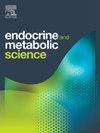The association between testosterone levels and diabetic nephropathy in Egyptian men with type 1 Diabetes Mellitus
Q3 Medicine
引用次数: 0
Abstract
Background
Type 1 diabetes mellitus is a chronic illness characterized by the body's inability to produce insulin due to the autoimmune destruction of beta cells in the pancreas. It can develop in adults and is often onset in childhood.
Objectives
To assess testosterone levels in Egyptian men with type 1 diabetes mellitus with and without nephropathy and identify its correlation with microalbuminuria.
Subjects and methods
This study was a case control study conducted at Diabetes outpatient clinic at Ain Shams University Hospital. The study was performed on diabetic subjects aging above 20 years old. The study included 120 participants with diabetes divided into 3 groups: 40 cases with type 1 diabetes and diabetic nephropathy, 40 cases with type 1 diabetes without diabetic nephropathy, 40 healthy males as a control group.
Result
Testosterone levels were higher in patients with T1DM than in healthy controls. Total testosterone levels were significantly higher in T1DM patients with diabetic nephropathy compared to those without diabetic nephropathy, mean = (653.208 ± 128.810) ng/dl versus (572.104 ± 146.024) ng/dl, p-value<0.01. Sex hormone-binding globulin showed no association with T1DM or diabetic nephropathy, p-value = 0.l.
Conclusion
The current study showed that testosterone levels were higher in participants with T1DM than in healthy controls. Also we found that total testosterone levels were significantly higher in T1DM participants with diabetic nephropathy compared to those without diabetic nephropathy. These results implicate that elevated testosterone levels could be the underlying cause of nephropathy in T1DM patients with nephropathy, and indicate that they may have a degree of androgen resistance for further research.
埃及男性1型糖尿病患者睾酮水平与糖尿病肾病的关系
背景1型糖尿病是一种慢性疾病,其特征是由于胰腺中的β细胞受到自身免疫性破坏而导致机体无法产生胰岛素。研究对象和方法本研究是一项病例对照研究,在艾因夏姆斯大学医院糖尿病门诊进行。研究对象为 20 岁以上的糖尿病患者。研究对象包括 120 名糖尿病患者,分为 3 组:40 名 1 型糖尿病合并糖尿病肾病患者、40 名 1 型糖尿病无糖尿病肾病患者、40 名健康男性作为对照组。有糖尿病肾病的T1DM患者的总睾酮水平明显高于无糖尿病肾病的患者,平均值=(653.208 ± 128.810)ng/dl对(572.104 ± 146.024)ng/dl,P值<0.01。性激素结合球蛋白与 T1DM 或糖尿病肾病没有关联,p 值 = 0.l. 结论 本研究表明,T1DM 患者的睾酮水平高于健康对照组。此外,我们还发现,与无糖尿病肾病的患者相比,患有糖尿病肾病的 T1DM 患者的总睾酮水平明显更高。这些结果表明,睾酮水平升高可能是T1DM肾病患者发生肾病的根本原因,并表明他们可能存在一定程度的雄激素抵抗,有待进一步研究。
本文章由计算机程序翻译,如有差异,请以英文原文为准。
求助全文
约1分钟内获得全文
求助全文
来源期刊

Endocrine and Metabolic Science
Medicine-Endocrinology, Diabetes and Metabolism
CiteScore
2.80
自引率
0.00%
发文量
4
审稿时长
84 days
 求助内容:
求助内容: 应助结果提醒方式:
应助结果提醒方式:


